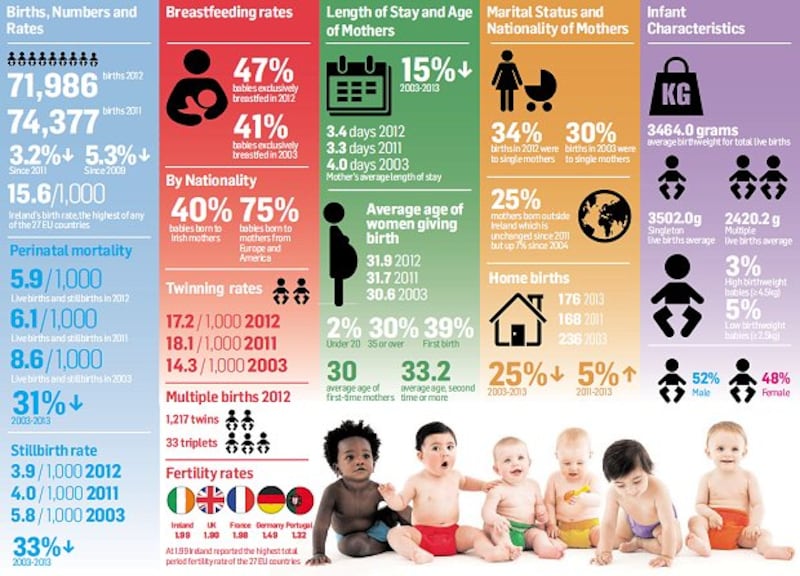Ireland’s baby boom may be easing off, but we continue to have the highest birth rate of any EU country. New figures released by the ESRI show there were 71,986 births last year, a 3 per cent drop from the previous year. This is the third year in a row that birth numbers have fallen.
"We can now see this is a trend, rather than just a blip," said Prof Miriam Wiley of the ESRI. "We've reached a tipping point."
In all, births are down 5 per cent since 2009. Despite the reduction, however, Ireland's birth rate still leads the rest of Europe by some distance. Ireland recorded 15.6 births per 1,000 population last year. Germany's birth rate, by contrast, was almost half that figure – 8.4 per 1,000 – and the European average was 10.4 . The countries which came closest were the UK (12.8 per 1,000) and France (12.6 per 1,000).

While the new figures provide a snapshot of what is happening in Ireland, they don’t explain why. “It’s complicated,” Prof Wiley said. “There is the dynamic of inward migration, the age profile of the population, the impact of the recession, lifestyle choices. They’re all part of a dynamic jigsaw puzzle.”
She said we were only getting to the stage where we would have enough data to begin explaining these patterns. What is clear, however, is that Ireland is exceptional in demographic terms. The high number of births over recent times can be explained by the high proportion of women in their childbearing years, rather than by a trend for women to have more children.
Immigration appears to have been a key factor behind this. The rise in birth rates gathered pace as inward migration increased dramatically from about 2004 onwards. In that year, for example, a total of 18 per cent of births were to mothers from outside Ireland. That figure reached 25 per cent in 2011 and remained unchanged last year.
Some experts suggest the easing off of the birth rate in recent times may be a postponement of childbearing and may not necessarily represent a decision to have fewer children.
In other words, people are put off having children during the economic downturn, and may catch up on fertility once economic conditions improve.
Certainly, women are waiting longer to have children. Figures show the average age of women giving birth was 31.9 years in 2012, compared with 31.7 years in 2011, and 30.6 years in 2003.
The total period fertility rate – the average number of children that would be born to a woman over her lifetime – is considered by many a better index of fertility than birth rates.
This is because it is independent of the age structure of the population. These figures also show Ireland is ahead of the rest of the EU, but by a much narrower margin. At 1.99, Ireland reported the highest total period fertility rate of any EU country, followed closely by France (1.98).
In 2011 – the most recent year for which data is available – the total period fertility rate for the 27 EU countries was 1.57.
Latest figures also show good news in the mortality rate of new-born babies.
The perinatal mortality rate – deaths that occur up to seven days after birth – have fallen by almost a third since 2003.
At the same time, mothers are spending shorter periods of time in hospital. The average length of stay was recorded at 3.4 days in 2012, compared with 4.0 days in 2003. This represents a decrease of 15 per cent over the decade.
The statistics on breastfeeding rates have been less impressive. While it is Government policy to promote this, less than half – about 47 per cent –of all babies were exclusively breastfed in 2012 at the point of discharge from hospital.
This is unchanged since 2011 and was reported at 41 per cent in 2003. When examined by nationality, the breastfeeding rate for Irish mothers was estimated at 40 per cent compared with over 75 per cent for babies born to mothers from Europe and America.











